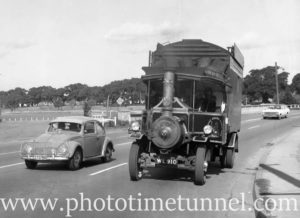Industrial and commercial newsletters and in-house publications are a rich source of fascinating historical material, often of a type that can’t be found anywhere else. One of my favourite Australian business journals is Bank Notes, the journal of the Commonwealth Bank of Australia. I pick up copies and bound volumes from time to time, mostly from the 1920s and 1930s, and love to comb through them for great old photos and articles about many aspects of Australian life. Mostly the articles are written by bank staff members, and the photos come from many sources.
Among the many articles I have found in Bank Notes are some by John Henry, who in the 1920s was the bank’s “Industrial Purpose Accounts Officer” in Newcastle. Mr Henry made it his business to visit some of Newcastle’s bigger industrial plants and he wrote some accounts of his visits. In this June 1925 article, for a change, he describes his family holiday at the Gloucester Tops:
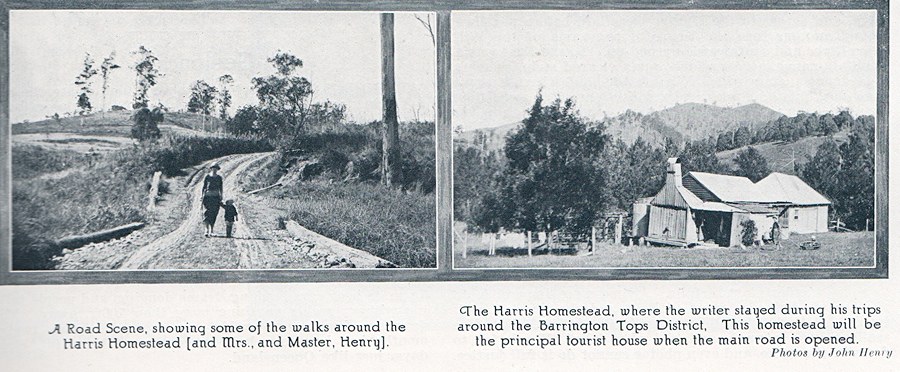
Although many of us have different times read with interest of the discovery of the famous Barrington tops, few to date have had the delightful opportunity of visiting that district. During my recent holiday tour I was successful in visiting most of the Barrington district and I will endeavour to describe as far as possible what wonderful attractions that this beauty spot holds for the future tourist of Australia and I feel quite safe in saying that it no distant date Barrington Tops will with very little effort rival our famous Mount Kosciusko.
After a very pleasant journey by mail train from Newcastle we arrived at Dungog, a very thriving agricultural and dairying district about 60 miles from Newcastle, where we were met by car. We had to make a journey of 24 miles through wonderful country in order to reach the Harris homestead where we were to spend a few weeks while touring the Tops district. The whole journey by car was over an excellent road and for the first six miles out of Dungog the huge water pipe (3 1/2 feet through) ran parallel to our car road. This water pipe comes from the famous Chichester Dam and it is by this means that Newcastle and district are supplied with water in abundance and, according to our car driver, this dam has made our coal districts absolutely secure from a water famine for practically all time.
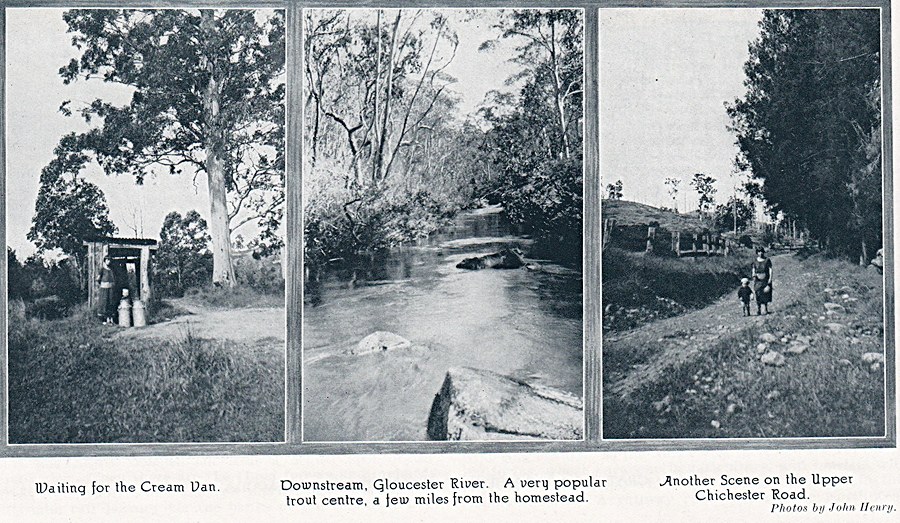
After turning off the Dungog road at six miles and leaving the water pipes behind we entered the Williams River road, passing beautiful grazing areas and dairy farms on both sides of us, and after seven miles we came onto the main Chichester road then onto Tunnybuck Crossing, 14 1/2 miles from Dungog. From here we started to climb the famous Tunnybuck Mountain, and and the scenery looking down on the Tunnybuck River suspension bridge and the famous Chichester Valley was without doubt some of the finest mountain scenery the writer has ever had the pleasure of seeing.
In the distance our motor driver pointed out the blue line of the beautiful Gloucester Ranges, which at this time I had no idea I was in a few days to go over on horseback. Perhaps it was just as well otherwise I may have persuaded our driver to keep the car at the homestead.
Continuing our journey down the Tunnybuck Range we came onto Craigs Flat and passed the little country church by the wayside and the public school. Then on the car sped till we came to our first crossing in a motor car and the Chichester River seemed to know I was from the city and rushed at the car with a louder roar than usual. Yet what appeared a miracle to me was expressed by the driver as “Good-oh” to what it is sometimes. Eventually we got the car to swim the river. We then came to a few more similar crossings and presently ascended the foot of the Gloucester Ranges known as Mount Nelson, and it is at the foot of this mountain that the little homestead is nestled at which we arrived in time for a good cup of afternoon tea. We received such a welcome to our new residence as only the bush people know how to give.
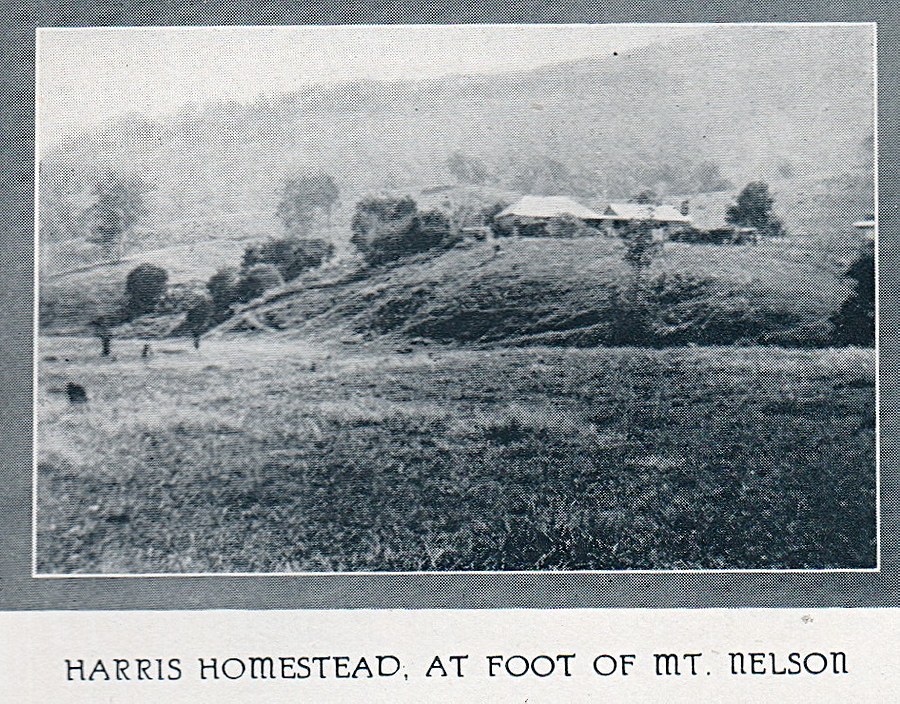
I must say we enjoyed the trip out from Dungog very much and had my sightseeing ended there I would have been quite satisfied just to see such beautiful trees as blue gums, brush box and birds of all descriptions; wonderfully coloured parrots, gillbirds, wild turkeys and pheasants and beautiful shrubbery – everything seemingly welcoming us to our new surroundings was a fine experience, and helped us more thoroughly to enjoy the beauties of nature.
After a good night’s rest in our new bush home I next morning made the acquaintance of all the surroundings of the farm and before many days was able to act as a spare hand to feed pigs, calves, turn the separator and in fact do everything except breaking horses.
I was very fortunate in making the acquaintance of Mr Bill Simmons who was at that time stopping at the homestead. Bill is known throughout the district as a wonderful guide and it did not take me long to find that he is well deserving of the title, for thanks to him and Mr Henry Harris I was able to see the Tops district with perfect ease. How these two wonderful guides can find their way out in the brush where they used to take me is a mystery I’m still trying to solve. The Harris homestead dates back as far as 1866 when the father of the present owner settled in that district and the Mr Harris of today still carries on the family traditions of hospitality and friendship. Just think of the life of those early pioneers in their district! Mr. Harris proudly exhibited two iron shoes which were once the property of John Cornwall, better known as “Underbank Jack” and were worn by his faithful mule when he roamed over those mountains 50 years ago after wild cattle. Wild cattle and cedar are no more. Milch cows and paspalum have now taken their place. After about a week at the homestead preparations were made for a trip to the Tops and one fine morning with a cloudless sky and a keen fresh breeze such as is known only to these districts we set off after an early breakfast with pack horses and guides for a wonderful journey.
The climb commenced immediately, since the homestead property backs up onto the slopes of Mount Nelson which we had to cross. The track is known as the Moppy Track and has been used for years. The earlier cedar getters brought many a valuable tree across it. Nowadays mobs of cattle use it and even a flock of turkeys has been driven over to the Gloucester side. Of late years some cuttings have been made around the steep parts and at present the grade is good except for a final trot over the last part of Mount Nelson.
As the climb proceeded wonderful panoramic views were unfolded before us. To the west were rolls of mountains; on the east thickly timbered ridge after ridge lay in quiet splendour; to the south the glory of all was seen, Dungog looking a speck in the hills; beyond one could see miles and miles to the south and also out across to the hunter.
It was a truly wonderful sight. All the way to the Tops this view is obtainable through the treetops and over the gullies. Even for the beautiful views on the ride up our trip was well worthwhile. Then there were the ferns of every description, grass trees and stag horns in profusion. We came across one tree in particular which was most interesting and in fact a nature’s wonder. Moss covered the trunk and branches; staghorns, birds nests literally clothed it. It was a veritable home for fairies and it really was very hard to realise it as existing in this realistic world.
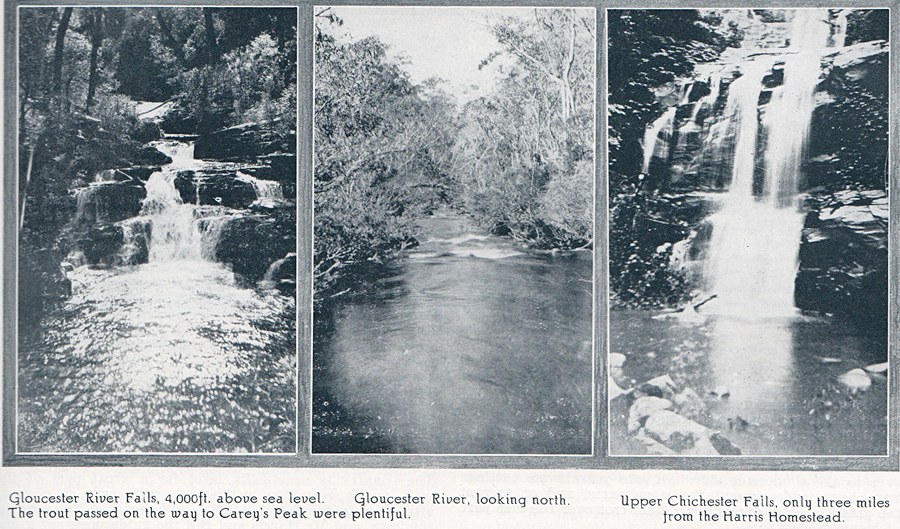
As we proceeded upwards we caught a glimpse of Bald Nob, southwest of Careys Peak but Careys was at that time very hard to pick out. The Upper Williams, Upper Allyn and across to the Hunter were laid before us, then around another turn that beautiful panorama of the Williams River and southward opened up. To the east was a mountain range across which was a cleared strip seeming to be about a chain wide. What it was and where it is we knew not but the guides had recollections of it sometimes seeing it from the Dungog-Gloucester Road way back in the Ranges. The surrounding countryside seems very diminutive indeed when one is on what appears to be the roof of the whole district.
After two hours’ ride from the homestead we arrived at the Gloucester Tops, 4000 feet high, and the atmosphere verified the height. The country at this height is similar to Barrington Tops and in this pleasant locality we spent a few hours photographing the wonderful views. Our guides informed us that the Gloucester River at this point contains fine trout and a number of our members soon verified their statement. About half a mile walk down the river we came to some wonderful waterfalls. Some were impossible to photograph both for want of light and the physical risk involved. A photo of Gloucester falls – 4000 feet above the sea level – was secured, and oh, what falls! Words fail to describe the scene and even photos cannot do it full justice.
The Gloucester Tops, in the writer’s opinion, are quite enough attraction on their own. The wonderful panoramic views, the glorious gorge and falls and the tree ferns; all these wonders of nature are quite sufficient for sightseers without even going on to Barrington Tops. On returning to our horses we made for Careys Peak. The country is practically level for a great part of the way and a very fine bridle track will serve as a great attraction to the future tourist. We reached the peak at sundown and Mr Harris and Bill the guide had prepared a fine meal for us, including the trout we had caught in Gloucester River at lunch time. A big fire was soon set going and huts made of cabbage tree and fern tree made us one of the cosiest rooms I’ve ever slept in and successfully sheltered us from such a frosty night as Careys Peak knows how to provide. After a comfortable night’s rest we were up early, and the writer having decided he had gone far enough in the saddle we looked at the white head of Barrington in the district and then turned our horses back for home which we reached as the tea gong was going the same evening. I might say that for about seven days after we returned I went for beautiful walks in the valleys of the Chichester River within easy reach of the homestead, for the saddle seemed very hard to forget.
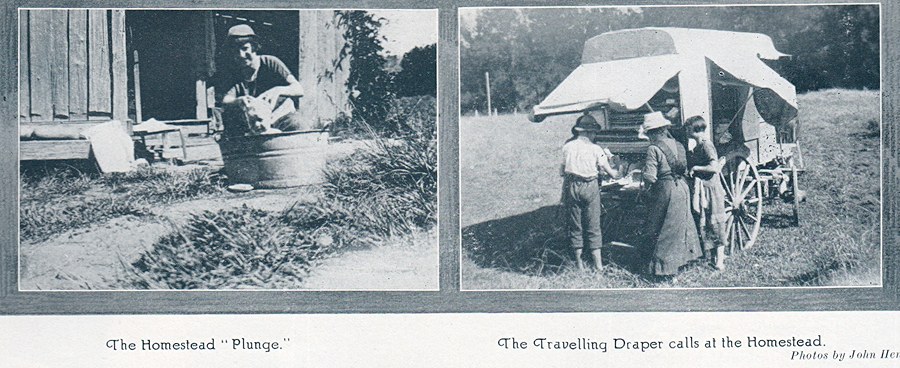
In conclusion, Mr Editor, I would like to say that the district I have endeavoured to describe is one of the finest holiday spots in New South Wales, with plenty of shooting and farm life on the Harris homestead, the tourist centre to the tops. They gave me the best holiday I have ever had.



